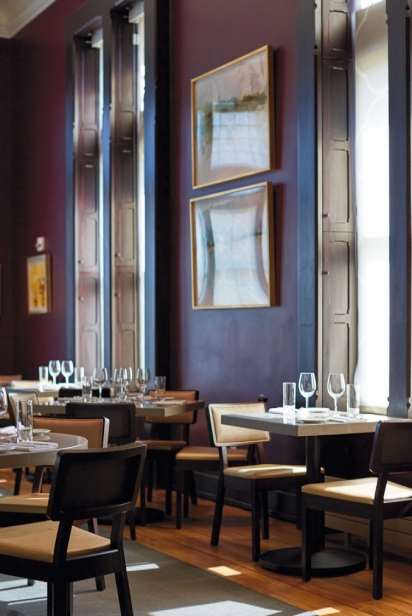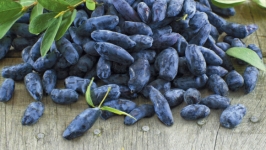Richardson Olmsted Campus: Holistic architecture, a therapeutic landscape and historic garden revived
Every year summer is welcomed like a friend we haven’t seen in years. Summer is also a time when the nurturing of land, seeds and gardens comes to fruition, meaning fresh food is abundant. But though garden-to-table was the primary source of produce for families and restaurants in the past, interest in agriculture and growing gardens waned as modernity encroached.
Today, “garden to table” is new branding for an old concept. On contemporary restaurant menus, the introduction surprises guests with freshness, quality and the creativity chefs are exploring based on their garden harvest. In an unlikely Buffalo location, a garden originally built in 1870 on the site of a former asylum is supplying fresh flowers, herbs and vegetables to a new restaurant and luxury hotel.
The story began in the late 1800s when medical wellness via architecture and landscape were merging into a new paradigm. Dr. Thomas Story Kirkbride, a psychiatrist from Philadelphia who was concerned about the moral treatment of patients with mental illnesses, wanted to improve hospital conditions typical of the time.
He believed sunlight, staggered wings, large spaces, fresh air and expansive farmland were vital for patient recovery. Kirkbride’s ideas evolved into an innovative architectural design and changed the way mental health hospitals were built at the end of the 19th century.
In 1872, construction began on Kirkbride’s vision, now The Richardson Olmsted Campus in Buffalo. Formerly known as the Buffalo State Asylum, it opened in 1880, though construction would continue for another decade on this testament to Kirkbride’s progressive plan. Uniting his dedication to improving the treatment of the mentally ill, the massive rusticated stone architecture of H.H. Richardson, and the landscape design of Frederick Law Olmsted and Calvert Vaux was a remarkable achievement.
In 1871 Olmsted helped Richardson position the structure in order to maximize natural light that would fill the interior throughout the day. The building sits according to southern exposure rather than parallel to the street. Six years after admitting the first patient, Olmsted and Vaux designed the landscape and plantings.
As cities grew increasingly mechanized, populated and ordered, residents sought transcendence in rural landscapes—an idea that permeated Kirkbride and Olmsted’s planning. They believed urban residents and patients needed to escape the chaos of the city and surround themselves with nature. Olmsted was interested in unconscious influence (character communicated at a level below that of consciousness rather than verbally) and applied this idea to his landscapes and the scenery they evolved into.
Kirkbride’s intention for wellness and horticultural therapy determined that at least 100 acres were necessary to create a bucolic environment for patients and allow enough land for gardening and farming. In addition to work therapy such as laundry and woodworking, he believed gardening, farming and access to fresh air were therapeutic.
The expansive acreage allowed the hospital autonomy in food production from farmland, a pig farm and greenhouses. The site originally occupied 203 acres but has been reduced several times over the years to about 90 acres today. The largest reduction was in 1927 when half the land was used to develop Buffalo State College.
Construction of a greenhouse was always part of the plan, though it wasn’t built until 1888. Designed by local architect W.W. Carlin, the original building included a perimeter wall 16 inches thick and four feet tall. The wall supported a glazed superstructure with cast iron and steel structural framing that enclosed 5,100 square feet. An addition to the greenhouse led to the cruciform footprint that still exists.
The superstructure was renovated with noticeable changes in a photo from 1960. By the late 1980s, the glass structure had deteriorated and become structurally unsound, which caused it to be demolished along with the interior brick wall partitions.
By the 1970s, patients were moved to a new building. The original building began to disintegrate and was eventually abandoned. Although the building was placed on the National Register of Historic Places in 1973, it wasn’t until 2006 that Richardson Center Corporation Board of Directors were appointed to save this architectural treasure.
The first phase of renewal consists of developing the site as a hotel and conference center intertwined with an architectural center in a third of the building space. This phase also includes restoring the south lawn landscape, restoring the central administration building and one section on each side, repurposing the restored space into an urban resort called Hotel Henry, and adding a restaurant named 100 Acres which pays homage to Kirkbride’s acreage requirement.
With a five-year plan currently underway, the reawakening of the garden is an extraordinary preservation aspect of the project. In the summer of 2017 the garden grew produce, herbs and flowers. According to Diana Principe, a partner in the hotel and restaurant, the garden yielded enough flowers for hotel guest rooms and herbs for the restaurant.
This season, carnations will be grown to brighten guests’ rooms, and to be used by 100 Acres in edible floral garnishes. Also continuing to grow will be lovage, an aromatic perennial plant that tastes like a cross between celery and parsley and offers a variety of culinary uses.
Principe explained that additional produce is only sourced from local farms within a 30-mile radius to align with sustainable practices. Selectively sourcing for quality rather than quantity translates into the freshest food for diners and hotel guests. The menu at 100 Acres usually changes twice a week to accommodate varying readiness of produce and herbs through the seasons. Thecocktail menu also reflects the availability of herbs from the garden. A new cocktail called Lavender Fields made from house-made lavender bitters along with gin, lemon, Crème di Violette and sugar will be added to the menu this summer.
On a recent tour with Gardener John C. Santomieri, I saw that a cluster of tall conifers on the south lawn believed to be original to the landscape appeared to be in harmony with the late afternoon sunlight. Where an orchard once existed, a mature apple and cherry tree now coexist with new plantings that connect to the historical landscape. Recurring themes of regeneration, wellness and the cyclical pattern of life are ubiquitous as the restoration project continues. TheRichardson Olmsted Campus echoes the importance of well-designed architecture, the curative value of landscape and gardens, and most importantly, the compassionate treatment of patients.
Dr. Kirkbride’s insight continues to offer tranquility through the architecture and landscape, and the revitalized garden inspires a new generation of chefs and their communities.
> Richardson Center Corporation: 444 Forest Ave, Buffalo; 716-601-1150; richardson-olmsted.com
> 100 Acres: TheKitchens at Hotel Henry: Corner of Rockwell Rd and Cleveland Cir, Buffalo; 716-955-1511; 100acresbflo.com
Sources
Gerlach-Springs, Nancy; Richard Kaufman and Sam Bass Warner, Jr. Restorative Gardens: The Healing Landscape. Yale University Press, 2004
Kirkbride, Thomas Story. On the Construction, Organization and General Arrangements of the Hospitals for the Insane. Philadelphia, PA: Publisher unknown, 1854
Rogers, Elizabeth Barlow. Landscape Design. A Cultural and Architectural History. New York: Harry N. Abrams, Inc. Publishers. 2001
Simpson, Sharon and Martha Straus. Horticulture as Therapy: Principles and Practice. Psychology Press, 1997













